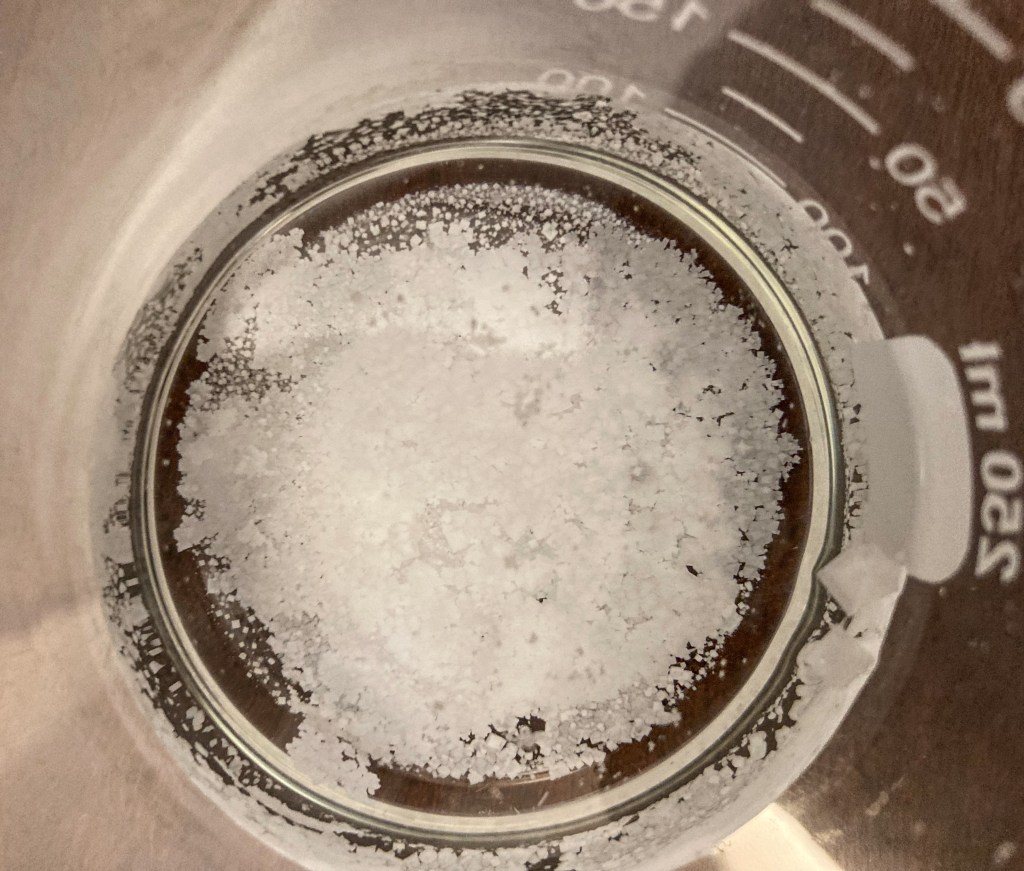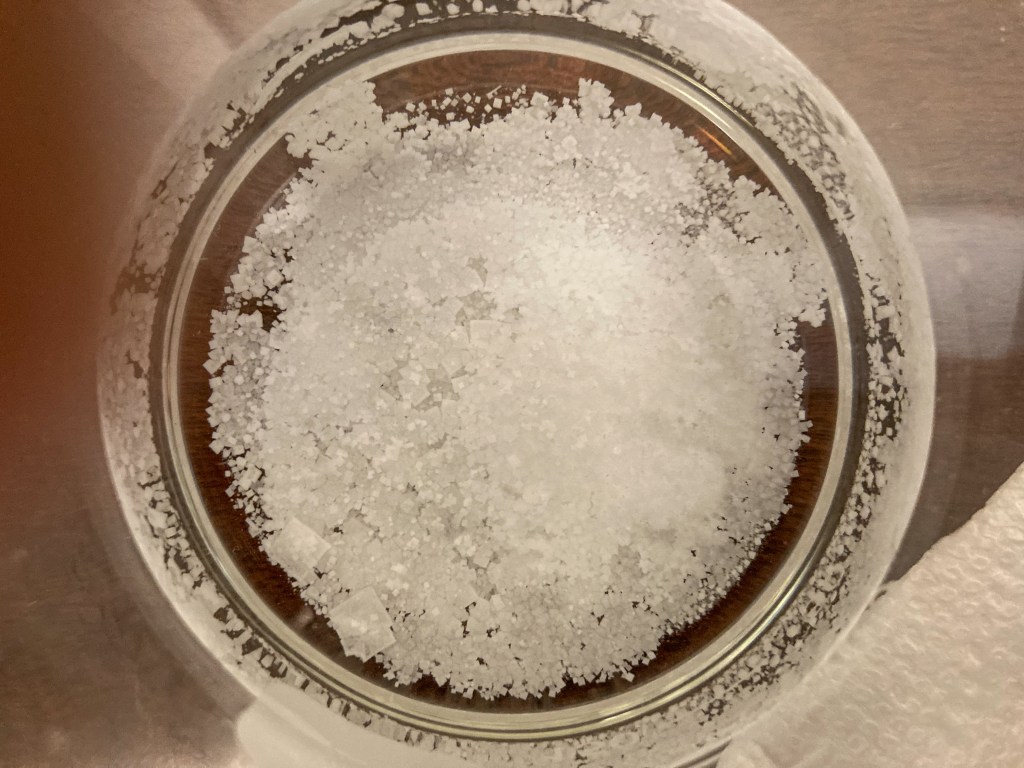When you leave a saturated NaCl saline solution in a glass cylinder, what happens when water dries up? Likely you thought cubic salt crystals would form at the bottom of the glass, and then grow bigger as water evaporates. You have this mental picture perhaps from reading a textbook, or maybe watching an animated video. Eventually only salt crystals are left in the cup. Well, that’s not wrong. But that is also not the full story.
What actually happens as salt water dries up in a cup is more complicated. You start with a glass cylinder about 2/5 filled with maximally-saturated salt water at 26 wt%, with about 1g of undissolved salt remaining, shown on the left. As water evaporates, at first those undissolved crystals continue to grow. But more crystals form on the surface of the solution. Before you realize, these crystals turn into lumps and form a seemingly live colonies of wet salt creeping up the glass wall. They will cover the entire inner wall, then march over and past the rim of the cylinder to the outside wall. By the time all water dries up, the glass cylinder is covered completely in a rind of salt, as shown on the right.

I couldn’t stop thinking, “what a creepy way for salt water to dry up!”
How I stumbled upon this phenomenon
I have been making solutions containing salt, glycerin and/or sodium polyacrylate lately, for some other projects. What those projects are is of no importance to the topic at hand. Suffice to say that I’ve had to make many saline solutions at different concentrations, including the maximally-saturated version at 26 wt%.
I had some unused amount of this saturated saline solution after a round of experiment. It’s still got about 1g of unresolved crystals in it. For fun, I left it alone. I thought it would be interesting to see how big those presumed cubic crystals could grow. I left it in an average home environment near the end of the winter. I would say the room temperature fluctuated between 65°F and 70°F. Humidity was between 39% and 42%.
I did not expect to see anything other than a neat pile of salt crystals left at the bottom of the glass, when all water dried up. Alas, that’s not what I found. And a quick search online did not reveal any pictures showing this phenomenon. Thus this article.
Day 1
This is a glass cylinder with roughly 250 mL capacity. It contains 100 g (or 100 mL) of water. There is 36 g of salt, slightly more than 35 g needed to produce a saturated saline solution at room temperature. About 1 g of salt did not dissolve as a result. The glass itself weighs 119 g. The scale shows 254.6 g which is close enough.
Day 3
I took a look at the glass two days after. This was not a proper experiment. Recall that I did not expect anything other than big crystals forming at the bottom. I wasn’t going to write down notes, or even take pictures. In fact, I forgot to check on the solution on the second day.
There were indeed a lot of additional salt crystals at the bottom of the glass. And they were all bigger than the fine crystals of table salt that I started with. Some grew from those table salt crystals. Others just decided to show up elsewhere on the bottom of the glass.
But there were crystals forming on the surface of the solution as well. That was unexpected. But I suppose it did make sense. I didn’t think much about these surface crystals. I took a pen and knocked all of those annoying surface crystals down. They all sunk to the bottom.
Day 4
Entire layer of crystal pancake formed on the surface again. I knocked down two layers of these in 24 hours. Now the surface of the solution looked clean. But you can see these layers starting to pile on top of the original heap formed from those table salt crystals. I decided that I should take regular pictures going forward.
Day 5
Compare Day 5 to Day 3. Crystals are growing bigger and more numerous. They continue to lump together as they bump into one another. More surface pancakes have been sunk, to join their brothers and sisters on the bottom.
Day 6
Check out some of these gigantic salt crystals. The crystal community is growing nicely.
A pancake of surface crystals can be clearly seen in the picture shown below left. This pancake is mercilessly sunk as usual. But from this point on, I decided to take a laissez-faire attitude towards these pancakes. Maybe I should have left them alone all along. Solution level has now dropped to 100 mL. And more crystals continue to accumulate on the bottom. Did you notice the leaflet of salt creeping up the wall of the glass in the background? That’s a harbinger of things to come.
Day 11
I had lost interest by Day 6. The surface pancake was unexpected. But I’d seen enough of them. So imagine my surprise when I looked at the glass cylinder on day 11. I found a live and wet colony of salt crystals crawling up the glass wall.
I thought this anomaly would ruin my time-lapse pictures. So I scraped a circular band of them salt crystals off the wall, cutting the colonies off from their solution supply.
Day 16
When I remembered to check on my salt evaporation experiment, the supply has been reestablished. The wet salt colony was growing stronger than ever before. While it has not occupied all available wall surface, it has already reached the rim of the cylinder. I renewed my laissez-faire stance, and decided to really leave my salt colony alone this time.
Day 20
When I looked again, almost the whole wall was now covered. The colony was even growing on the outer wall of the cylinder. This was quite amazing. Note that the solution level now measured slightly more than 50 mL. But actual solution amount was clearly much less than that, due to the big pile of salt crystals sitting on the bottom.
Day 25
It wasn’t clear to me when the solution completely dried up. By day 25 when I checked, all water was gone. There is now a thick rind of salt crystals encasing the glass cylinder. Pictures shown below were taken on day 25, and after. It made no difference, now that the solution had turned into pure crystals.
Here is a comparison of the same glass cylinder on day 1, and after day 25. The difference in weight is almost the 100 g of water that went into the saturated solution on day 1.
Last words
I figure that the creeping expansion of the colony was based on capillary action. I imagine that crystal on walls provided far more surface area compared to the leveled surface of the solution. I don’t actually know when the cup completely dried up. But likely the evaporation action accelerated exponentially past day 20.
Before I wrote the article, I did not manage to find images online that showed this phenomenon. After writing the article, I searched again with actual words I came up with in the article to describe this phenomenon. One combination struck gold. That’s “salt creep”. This phenomenon is known as salt creep apparently. Well. Now I know.
Here is a last look at the glorious, but now dead salt colony.



















